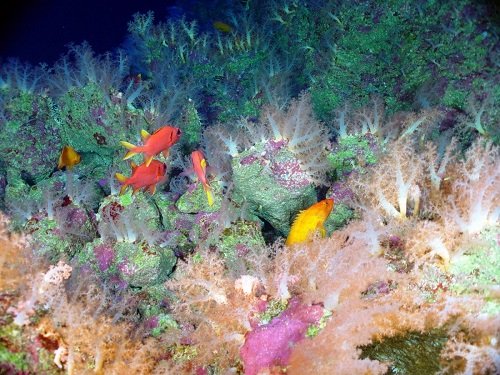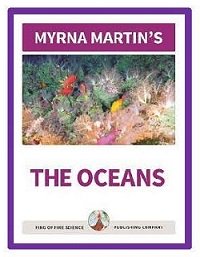Fascinating Facts about the oceans
the world Ocean
The World Ocean is the name for the five interconnected oceans on our planet. The World Ocean covers 70% of the Earth’s surface. The largest ocean is the Pacific Ocean that covers 30% of the surface of the Earth. The Atlantic Ocean covers 21% and Indian Ocean covers 14% of the Earth’s surface. The Southern Ocean is the newest named ocean and it extends from the coastline of Antarctica to 60 degrees south latitude in all directions. The Arctic Ocean is the smallest ocean.
Seas are smaller than oceans. They are usually located where the land and ocean meet. Typically, seas are partially enclosed by land. The Mediterranean Sea is a sea connected to the Atlantic Ocean. It is surrounded by the Mediterranean Basin and is almost completely enclosed by land on the North.

Diamante Volcano a seamount in the Pacific Ocean NOAA
Recent Discoveries
Three oceanographers went down in a mini-submarine in 1977 to study a divergent boundary. They wanted to find a volcanic vent located on the seafloor. They found the vent and an entire new ecosystem of animals living around Black Smokers.
Black Smokers are chimneys of chemicals that form on the seafloor above the vent. Microbes turn the chemicals coming out of the vent into energy. Over 600 new species have been found around the vents including giant tube worms that feed off the energy produced by the microbes. More facts about the oceans are being discovered by scientists in mini-submarines each year.
Deep-sea Coral reefs
New facts about deep-sea coral reefs are being discovered. Just a few years ago it was thought that stony corals could not live without sunlight. The algae that creates 90% of the coral’s food requires sunlight in warm tropical waters. Deep-sea stony corals feed on food brought to them by the currents in the oceans.
Deep-sea corals live between 45 m and 3000 m below the surface of the ocean in all the oceans. They grow slowly on seamounts, continental slopes, underwater canyons and the seafloor. .
Each year deep-sea corals grow annual rings just like trees. Scientist determine the age of the animals by their growth rings. One colony of deep-sea corals has been growing in an area for over 4000 years. The oldest known animal on Earth was a black coral. Scientists dated its age at over 4,250 years old.

The Oceans includes chapter on whales, sharks, giant clams and tsunamis. New facts about the oceans that have been discovered recently are also included in this book. Myrna

Click for More Information and to Order
Diving to the Deepest points in the the Oceans
Challenger Deep is the deepest known point in all the oceans. The first manned descent was made by Jacques Piccard and Lt Don Walsh on January 23, 1960. They stayed just 20 minutes on the seafloor because an outer window cracked.
James Cameron made a solo dive to the bottom of the Challenger Deep 52 years later. Cameron manned the Deepsea Challenger for his epic trip to the bottom of the Challenger Deep on March 26, 2012. He spent 2 hours and 36 minutes before he had to return to the surface. A fluid leak cut short his planned 6-hour trip.
The Five Deeps exploration by Victor Vescovo
Victor Vescovo, dove to the deepest points in all five oceans. He completed his epic adventure in August 2019. The Discovery Channel will air a five-part documentary on the trips. New facts about the oceans will be included in this documentary series.
These are the dates each dive took place:
December 2018 - Puerto Rico Trench in the Atlantic Ocean
February 2019 - South Sandwich Trench in the Southern Ocean
April 2019 - Java Trench in the Indian Ocean
May 2019 - Challenger Deep in the Pacific Ocean
August 2019 Molloy Deep in the Arctic Ocean
More facts about the oceans
Colorful Caribbean spiny lobsters Caribbean spiny lobsters are found in tropical and sub-tropical waters. They are famous for their migration each year to and from deep waters.
Are rogue waves a myth? Rogue waves were believed to be tall tales told by sailors for centuries during shore leave. Today instruments have detected these waves and a film crew took a movie of one striking a fish boat.
Ghost crabs live on tropical beaches These tiny crustaceans begin life as larvae floating in the ocean. They come ashore to live their adult life on the beaches where they build elaborate burrows.
Unknown life around black smokers Black Smokers are hydrothermal vents that
were discovered by scientists in 1977. The animals living around the vents do
not need sunlight to survive
Our Blue Planet The Oceans cover 70% of the Earth. We are still learning about many of the animals and plants that live in the oceans.
Crustal plates pulling apart create rift valleys Rift valleys would look like seams on a baseball from space if all the water on our planet suddenly disappeared.
Did you know marine sponges are animals? Marine sponges are sessile animals that look like plants. Some marine sponges live on the seafloors over 8,800 meters (5.5 miles) deep
Viperfish are fierce predators Viperfish are one of the fiercest predators living in the deep ocean that attract their prey with a “fishing lure”
Four major oceanic zones Oceanographers divide the oceans into oceanic zones. Most plant and animal life live in one specific zone.
The 2004 Indian Ocean tsunami and earthquake The 2004 Indian Ocean Tsunami was the deadliest tsunami known to occur on our planet.
Australia's Great Barrier Reefs The Great Barrier Reefs are so large astronauts can see them at the International Space Station.
The Atlantic Ocean is increasing in size The Mid-Atlantic Ridge is a divergent boundary that runs down the center of the Atlantic Ocean. Iceland sits on the Mid-Atlantic Ridge.
KIDS FUN Science Bookstore
Check out Myrna Martin's award winning textbooks, e-books, videos and rock sets. The Kids Fun Science Bookstore covers a wide range of earth science topics. Click here to browse.










